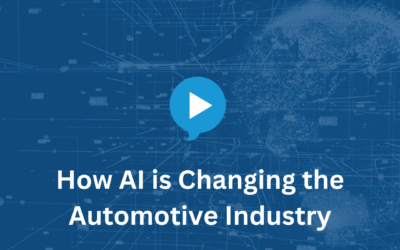Much has been made of the incorporation of Artificial Intelligence (AI) into our daily lives over the past six months. Writers, artists and musicians assert that it’s the end of the creative industry because AI can manufacture work that looks and sounds like theirs without having to compensate them or, in some cases, even give them credit. On the other hand, business managers and administrators are hailing AI for relieving them of time-consuming tasks like corporate emails, memos and status reports. AI has given these people more bandwidth to do the most interesting and engaging parts of their jobs.
The automotive industry has been one of the early adopters of AI. The implications for manufacturing, engineering and design were evident immediately. Of course, automakers were also quick to realize the AI is only as good as the humans who are giving it the information it needs to function properly. Manufacturers knew they couldn’t just tell AI to make them a car and then go out for coffee and a bear claw. They had to supply their AI with the brand’s history, specs and design criteria first.
One facet of the auto industry where AI has tremendous potential is in service. Enterprising dealerships understood that AI could improve the entire customer experience. Early adopters used industry-specific AI-driven software to enhance every aspect of the customer journey. They found that with the right SaaS partner, they could easily integrate an AI-powered video and messaging communication platform into their current DMS.

How Does AI Improve the Customer Experience in this Format?
Well, take messaging for example. Service advisors who are communicating via text with customers are often too busy to write grammatically correct, well-worded messages. The result can be miscommunication or misunderstanding which frustrates customers and creates a poor experience. AI can take a hastily written text and suggest different words, phrases and punctuation that make the message clearer and more professional.
Can AI Actually Tell How Customers are Feeling?
A good service advisor or manager can sense when a customer isn’t happy. Body language and tone of voice let them know that there’s about a big scene with a lot of yelling and recriminations. Usually, these kinds of situations can be avoided with some personal attention and a few soothing words. But what happens when a customer isn’t physically in the dealership? How is the service advisor to know that something is wrong?
Using AI Sentiment Analysis, we can now understand how the customer feels in real time even if they aren’t present. AI models that are specifically trained for automotive sentiment can analyze a customer’s text messages and alert the service advisor when the language in those messages becomes emotionally charged. That way, the service advisor can address any issues immediately just as they would if they were face-to-face with the customer.
This game-changing technology is eliminating the need for customer surveys, which have been historically flawed in providing timely and actionable feedback.
Where Else is AI Key to Successful Customer Communication?
Video is now being used in many service centers to build trust and transparency with customers by showing them what the technicians have discovered in the vehicle inspection. But, there’s one major issue: Service bays are loud. That means the technician’s explanation of recommended repairs and services can be lost in a cacophony of air guns, air chisels and hydraulic lifts. Fortunately, there’s available AI that trains to the technician’s voice and blocks out all other sounds so that the narration of each video is crisp and clean.
Is There a Use for AI in a Part of the Customer Experience You Might Not Expect?
Every service manager has had a disgruntled customer on their hands at one time or another. The good ones know to diffuse a difficult situation and even turn it into a positive interaction. But service managers can’t react in a timely manner if they don’t know that a customer is upset. AI can actually gauge a customer’s feelings in real time by flagging angry words in a text message and alerting the service manager immediately. It gives the service center’s best communicators the ability to address a small problem before it becomes a big one.
Are There Any Other Ways AI Could Help a Dealership’s Service Center?
Earlier, we mentioned the noisy atmosphere of a service bay and how AI could remedy that in an inspection video. But what happens if the customer is in a noisy environment when they receive the video? They might not be able to hear what the technician is saying regardless of how pristine the sound is. Or maybe they find themselves in a place where they can’t use the volume on the phone (like a business meeting or a school play), but want to watch the video so they can authorize the repairs. AI can generate subtitles that automatically play with the video and allow customers to read anything they can’t hear.
There’s also another, more obvious use for AI. Customers who don’t speak English are often reluctant to authorize repairs because they don’t completely understand what the service advisor is texting them. While services like Google Translate have been available for several years, most users know that those translations are often unreadable or simply wrong.
The latest, highly trained AI Large Language Models (LLMs) can translate a text message conversation between a service advisor and a customer who speaks a different language with an extremely high level of precision. So, communication is always clear and personalized, which makes the customer feel more comfortable with approving services and repairs.
Going forward, AI will also have the ability to adopt the tone and manner of each dealership’s brand. So, if the national brand voice revolves around being reliable, each message will have language that reflects the attributes of reliability.
To be clear, for as much as AI can already do it is still very much in its infancy. Any industry that values high quality customer communication, which is to say every industry, will be watching closely as AI capabilities continue to evolve. In the meantime, the automotive industry will enjoy the best that AI has to offer right now.
Oh, and in case you were wondering, the blog was written by a human. After all, AI is nothing without us.
Interested in learning how AI can help your dealership?
If you’re looking for an effective communication solution that can help improve your dealership’s productivity, TruVideo can help you get started. Our video texting platform integrates seamlessly into your dealership’s existing workflow, making it easy to start communicating effectively with your customers. Book a demo to learn more about implementing this system for your dealership.



